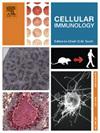Polymorphonuclear myeloid-derived suppressor cells protect against hyperoxia-induced bronchopulmonary dysplasia in neonatal mice through suppression of excessive inflammatory response
IF 2.9
4区 医学
Q2 CELL BIOLOGY
引用次数: 0
Abstract
Background
Bronchopulmonary dysplasia (BPD), which primarily affects premature infants, is characterized by impaired lung development, reduced alveolarization, and chronic inflammation, leading to long-term respiratory complications. However, clinical prevention treatment of BPD remains challenging. Because immune cells may have a role in BPD pathogenesis and prevention, we investigated whether polymorphonuclear myeloid-derived suppressor cells (PMN-MDSCs) protect against hyperoxia-induced BPD in a neonatal mouse model.
Methods
Neonatal C57BL/6 mice were exposed to either normoxia (21 % oxygen) or hyperoxia (85 % oxygen) since birth. Lung development was analyzed on postnatal days 3, 7, and 14 by using histological techniques [hematoxylin and eosin (H&E) staining and radial alveolar count (RAC) measurement]. Moreover, we used flow cytometry to identify lung myeloid-derived suppressor cell (MDSC) subsets. PMN-MDSCs' therapeutic potential at key developmental stages was evaluated through adoptive transfer experiments. PMN-MDSC transplantation outcomes in the lung tissues were assessed through histological analysis, immunofluorescence staining for alveolar and vascular markers, and proinflammatory cytokine measurement.
Results
Hyperoxia-exposed mice exhibited considerable lung damage, including enlarged and irregular alveoli, low RACs, and decreased body weights compared with normoxic controls. Hyperoxia reduced PMN-MDSC numbers but increased monocytic MDSC numbers. PMN-MDSC transplantation preserved alveolar structure and increased alveolar and pulmonary vessel numbers. Immunofluorescence staining confirmed enhanced alveolar and vascular development. Finally, PMN-MDSCs reduced proinflammatory cytokine levels in lung tissues.
Conclusion
PMN-MDSCs may protect against hyperoxia-induced lung injury by promoting alveolar and vascular development and reducing inflammation in neonatal mice. Further research elucidating precise mechanisms underlying the protective effects of PMN-MDSCs and their potential for clinical translation is warranted.
多形核髓源性抑制细胞通过抑制过度炎症反应来保护新生小鼠免受高氧诱导的支气管肺发育不良
支气管肺发育不良(BPD)主要影响早产儿,其特征是肺发育受损、肺泡化减少和慢性炎症,导致长期呼吸系统并发症。然而,BPD的临床预防治疗仍然具有挑战性。由于免疫细胞可能在BPD的发病和预防中发挥作用,我们在新生小鼠模型中研究了多形核髓源性抑制细胞(PMN-MDSCs)是否能预防高氧诱导的BPD。方法C57BL/6小鼠出生后分别暴露于常氧(21%)和高氧(85%)环境中。采用组织学技术[苏木精和伊红(H&;E)染色和桡骨肺泡计数(RAC)测定]分析出生后第3、7和14天的肺发育情况。此外,我们使用流式细胞术鉴定肺髓源性抑制细胞(MDSC)亚群。通过过继移植实验评估PMN-MDSCs在关键发育阶段的治疗潜力。通过组织学分析、肺泡和血管标志物的免疫荧光染色和促炎细胞因子测量来评估PMN-MDSC在肺组织中的移植效果。结果与正常对照组相比,低氧暴露小鼠表现出明显的肺损伤,包括肺泡增大和不规则,低rac和体重下降。高氧降低PMN-MDSC数量,增加单核细胞MDSC数量。PMN-MDSC移植保留了肺泡结构,增加了肺泡和肺血管的数量。免疫荧光染色证实肺泡和血管发育增强。最后,PMN-MDSCs降低了肺组织中促炎细胞因子的水平。结论pmn - mdscs可能通过促进新生小鼠肺泡和血管的发育、减轻炎症反应,对高氧诱导的肺损伤具有保护作用。进一步的研究阐明PMN-MDSCs保护作用的确切机制及其临床转化的潜力是必要的。
本文章由计算机程序翻译,如有差异,请以英文原文为准。
求助全文
约1分钟内获得全文
求助全文
来源期刊

Cellular immunology
生物-免疫学
CiteScore
8.20
自引率
2.30%
发文量
102
审稿时长
30 days
期刊介绍:
Cellular Immunology publishes original investigations concerned with the immunological activities of cells in experimental or clinical situations. The scope of the journal encompasses the broad area of in vitro and in vivo studies of cellular immune responses. Purely clinical descriptive studies are not considered.
Research Areas include:
• Antigen receptor sites
• Autoimmunity
• Delayed-type hypersensitivity or cellular immunity
• Immunologic deficiency states and their reconstitution
• Immunologic surveillance and tumor immunity
• Immunomodulation
• Immunotherapy
• Lymphokines and cytokines
• Nonantibody immunity
• Parasite immunology
• Resistance to intracellular microbial and viral infection
• Thymus and lymphocyte immunobiology
• Transplantation immunology
• Tumor immunity.
 求助内容:
求助内容: 应助结果提醒方式:
应助结果提醒方式:


